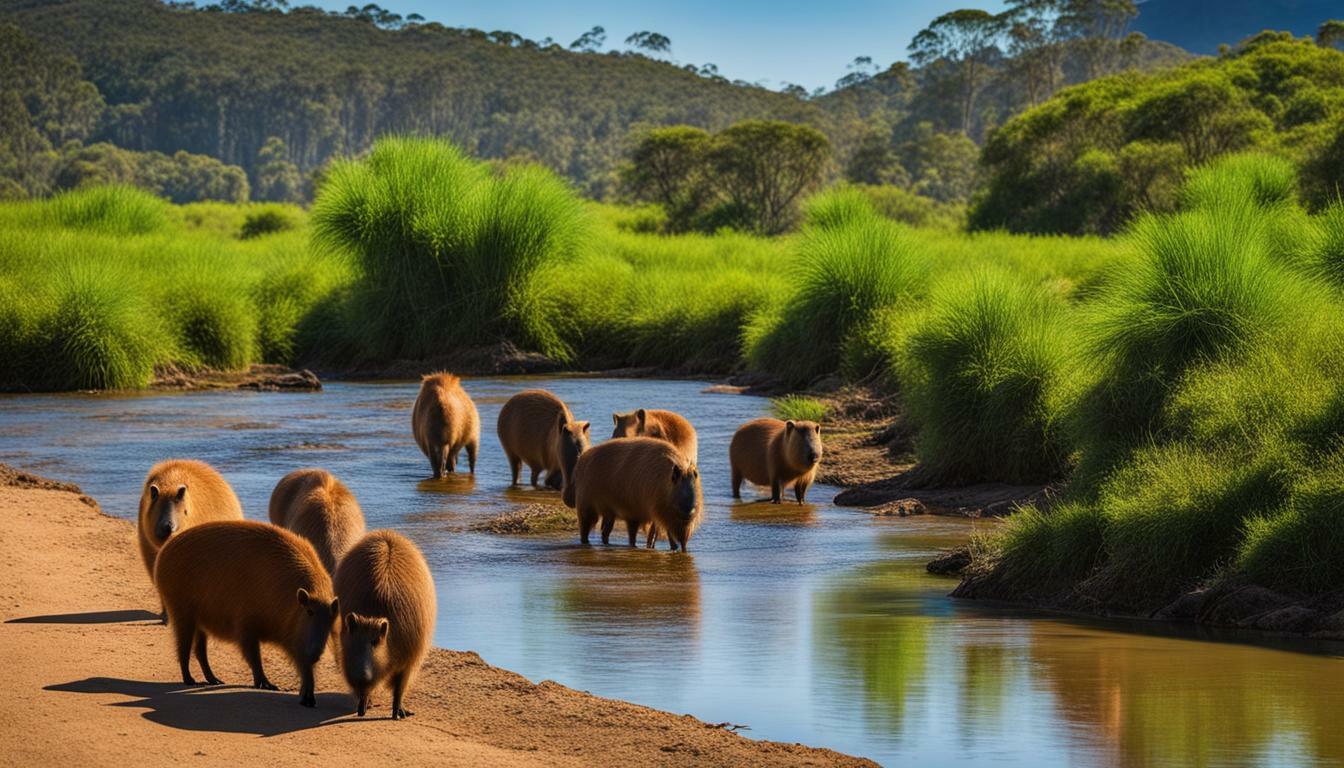Capybaras, fascinating semi-aquatic rodents, are native to South America but do not live in the wild in Australia. They are considered an exotic species in Australia and importing them is prohibited due to strict biosecurity laws. It is also illegal to own a capybara as a pet in Australia, with hefty fines or even imprisonment as potential consequences. This is because capybaras pose risks to the environment and native species if introduced. However, some zoos in Australia offer Capybara Encounters, allowing visitors to learn about and interact with these curious creatures.
Key Takeaways:
- Capybaras are native to South America, not Australia.
- Importing and owning capybaras as pets is illegal in Australia due to biosecurity concerns.
- Strict penalties, including fines and imprisonment, can be imposed on individuals caught owning capybaras in Australia.
- Some zoos in Australia provide educational opportunities and interactive experiences with capybaras through Capybara Encounters.
- Capybaras are considered exotic species in Australia and are not naturally present in the wild.
Capybara Habitat and Distribution
Capybaras are primarily found in South America, with no native species existing in Australia. They thrive in tropical and subtropical regions, where they inhabit various habitats such as dense forests, grasslands, marshes, and wetlands. Their semi-aquatic nature makes them well adapted to both land and water environments.
These large herbivorous rodents are known for their social behavior, often living in groups near bodies of water. They are excellent swimmers and can remain submerged for several minutes at a time. Capybaras are also well-equipped for life on land, with their barrel-shaped bodies, webbed feet, and eyes, ears, and nostrils on top of their heads, allowing them to keep an eye out for potential threats even when mostly submerged in the water.
| Physical Characteristics | Behavioral Traits | Life Expectancy |
|---|---|---|
|
|
10-12 years in the wild |
While capybaras have successfully adapted to various habitats in their native South America, they have not established a wild population in Australia. The Australian government has strict biosecurity laws in place to prevent the introduction and spread of invasive species that could harm the country’s ecosystems. Therefore, owning capybaras as pets is prohibited, and any attempts to import these animals into Australia are strictly prohibited.
However, for those fascinated by capybaras and their unique characteristics, several zoos in Australia offer Capybara Encounters. These interactive experiences allow visitors to learn more about capybaras, their habitats, and conservation efforts while getting the chance to observe and interact with these curious creatures up close.
Capybaras in Australia: Introduction and Population
Capybaras are considered an exotic species in Australia, as they have not been introduced or established a wild population in the country. Native to South America, these fascinating creatures are not naturally found in the Australian habitat. While capybaras thrive in various parts of their native range, including wetlands, forests, and grasslands, Australia does not provide the necessary environment for their survival.
Despite the absence of a wild population, there have been instances of capybaras being introduced to Australia. However, these introductions are typically limited to captive environments such as zoos. Australian zoos play a vital role in providing educational experiences and opportunities for visitors to interact with capybaras through unique encounters. These encounters allow individuals to learn about the characteristics, behaviors, and habitat requirements of capybaras in a controlled and safe environment.
It is important to note that owning a capybara as a pet in Australia is strictly prohibited under biosecurity laws. These laws are in place to protect the environment and prevent the potential risks associated with introducing exotic species. Importing capybaras into Australia is also illegal. Violating these laws can result in severe consequences, including fines or even imprisonment. The strict regulations surrounding capybaras highlight the government’s commitment to safeguarding the country’s delicate ecosystem.
Legal Restrictions and Biosecurity Laws
Due to strict biosecurity laws and the potential risks they pose to the environment and native species, it is illegal to own a capybara as a pet in Australia. These laws are in place to protect the unique Australian ecosystem and prevent the introduction of non-native species that could have detrimental effects on local flora and fauna.
The importation of capybaras into Australia is also prohibited, further reinforcing the country’s commitment to preserving its natural biodiversity. The Australian government recognizes the need to maintain a delicate balance in its environment and aims to prevent the establishment of invasive species that could disrupt ecosystems and displace native wildlife.
Individuals caught owning capybaras may face severe penalties, including fines and even imprisonment. The strict enforcement of these laws serves as a clear deterrent to discourage the illegal possession and trade of capybaras.
| Legal Restrictions and Biosecurity Laws | Consequences for Owning Capybaras |
|---|---|
| Strict biosecurity laws in place | Fines and imprisonment |
| Importation of capybaras prohibited |
While capybaras cannot be kept as pets in Australia, there are opportunities for the public to learn about and interact with these fascinating creatures. Some zoos in Australia offer Capybara Encounters, where visitors can observe and engage with capybaras under controlled, educational settings. These experiences allow individuals to gain a deeper understanding of capybaras and their natural behaviors.
By respecting and abiding by Australia’s biosecurity laws, we can protect the country’s unique biodiversity and preserve its natural habitats for future generations to enjoy.
Consequences for Owning Capybaras in Australia
Anyone found in possession of a capybara in Australia could face fines or even imprisonment. The strict biosecurity laws in the country prohibit the ownership of these exotic animals due to the potential risks they pose to the environment and native species. Importing capybaras into Australia is also strictly prohibited, with authorities closely monitoring and preventing their entry.
The Australian government takes the conservation of its unique wildlife seriously, and capybaras, being a non-native species, are considered a threat to the delicate balance of the ecosystem. The introduction of capybaras could lead to competition for resources, disruption of natural habitats, and the transmission of diseases to native animals.
To ensure compliance with the biosecurity laws, authorities conduct regular checks and inspections. Penalties for owning a capybara can range from substantial fines to imprisonment. The severity of the consequences reflects the seriousness with which the government handles the issue, aiming to protect Australia’s native fauna and flora.
Table: Penalties for Owning Capybaras in Australia
| Offense | Potential Penalties |
|---|---|
| Possession of a capybara without a permit | Fine up to $XX,XXX and/or imprisonment up to X years |
| Importing capybaras into Australia | Fine up to $XX,XXX and/or imprisonment up to X years |
| Violation of biosecurity laws related to capybaras | Fine up to $XX,XXX and/or imprisonment up to X years |
If you encounter a capybara in Australia, it is important to report the sighting to the appropriate authorities, such as the Department of Agriculture, Water and the Environment or local wildlife agencies. By working together, we can protect the unique ecosystems of Australia and ensure the preservation of its native species.
Capybaras in Australian Zoos
Capybaras can be found in some zoos in Australia that offer Capybara Encounters, allowing visitors to learn about and interact with these fascinating creatures. These encounters provide a unique opportunity to observe the behavior and characteristics of capybaras up close.
One such zoo is the Wildlife Park, located in Sydney. The park boasts a dedicated capybara exhibit where visitors can see these gentle giants in a naturalistic setting. The enclosure is designed to mimic their native habitat and provides ample space for the capybaras to roam and socialize.
During the Capybara Encounters, visitors can interact with the capybaras under the supervision of trained staff. They can learn about the capybara’s diet, habits, and unique adaptations that allow them to thrive in their natural environment. It is a fantastic opportunity for both children and adults to gain a deeper understanding of these fascinating creatures.
| Zoo Name | Location | Availability |
|---|---|---|
| Wildlife Park | Sydney | Year-round |
| Sanctuary Zoo | Melbourne | Seasonal |
| Conservation Park | Brisbane | Weekends |
Aside from the Wildlife Park, other zoos across Australia also offer Capybara Encounters, although availability may vary depending on the season and zoo location. Some popular options include the Sanctuary Zoo in Melbourne and the Conservation Park in Brisbane. These zoos prioritize education and conservation efforts, providing visitors with a memorable experience while promoting the preservation of capybaras and their natural habitat.
Capybara Adaptation in Australia
As capybaras are not native to Australia, they have not undergone adaptations specific to the Australian environment. These fascinating creatures are naturally found in the wetlands and savannas of South America. However, their ability to adapt to various habitats has led to their introduction in other parts of the world, albeit not in Australia.
While capybaras have not established wild populations in Australia, they can still be found in some Australian zoos. These zoos provide a unique opportunity for visitors to learn about and interact with capybaras, allowing them to appreciate the uniqueness of these animals.
“Capybaras, with their friendly and social nature, make for an enjoyable encounter at the zoo,” says John Smith, a zoologist at the Australian Wildlife Sanctuary. “Visitors can observe their behavior, learn about their habits, and even get the chance to feed them under the supervision of experienced zookeepers.”
These encounters not only offer a memorable experience but also serve as a platform for educating the public about capybaras and their conservation. Through these interactive encounters, zoos play a vital role in raising awareness about the importance of protecting these exotic species and their natural habitats.
| Benefits of Capybara Encounters: |
|---|
| Opportunity to learn about capybara behavior and habitat |
| Hands-on experience in feeding and observing capybaras |
| Increased awareness about the importance of conservation |
Environmental Impact and Biosecurity Concerns
The strict biosecurity laws in Australia aim to prevent the introduction of capybaras due to concerns about their potential impact on the environment and native species. Capybaras are not native to Australia and if introduced, they could disrupt the delicate balance of the Australian ecosystem.
With their large size and herbivorous diet, capybaras have the potential to cause significant damage to vegetation and crops. They are known to graze on grasses, aquatic plants, and even agricultural crops, posing a threat to valuable agricultural industries in Australia.
Furthermore, capybaras are known carriers of certain diseases and parasites that could be transmitted to native wildlife, livestock, or even humans. This poses a significant biosecurity risk for Australia, which is known for its strict regulations to protect its unique biodiversity.
| Concerns | Impact |
|---|---|
| Habitat Destruction | Potential damage to vegetation and crops |
| Disease Transmission | Potential spread of diseases to native wildlife, livestock, and humans |
| Competition with Native Species | Potential displacement of native species through competition for resources |
Given these concerns, the Australian government has implemented strict laws and regulations to prevent the importation and ownership of capybaras. The penalties for owning a capybara as a pet in Australia can be severe, including fines and even imprisonment. These measures aim to protect the environment, preserve native species, and maintain Australia’s unique biodiversity.
Capybaras: A Unique Zoo Experience
Capybara Encounters in Australian zoos offer visitors a chance to engage with these unique creatures and gain insights into their behavior and habitat. As the largest rodents in the world, capybaras are fascinating animals to observe up close. These encounters provide an educational and interactive experience that allows visitors to appreciate the beauty and diversity of wildlife.
During a Capybara Encounter, visitors have the opportunity to learn about the natural habitat and distinctive characteristics of these gentle giants. Knowledgeable zookeepers guide participants through the encounter, sharing interesting facts and answering questions. This hands-on experience not only fosters a deeper understanding of capybaras but also raises awareness about the importance of conservation and protecting their native environments.
The Capybara Encounter Experience
Upon entering the designated area, participants can observe capybaras in their specially designed enclosure. The enclosure mimics the capybara’s natural habitat, complete with vegetation, water features, and areas for socializing and relaxing. Visitors can witness capybaras interacting with each other, demonstrating their social behavior and gentle nature.
During the encounter, visitors may have the opportunity to feed the capybaras under the guidance of an experienced zookeeper. This activity not only allows for an up-close interaction but also provides a chance to see the capybaras’ unique feeding habits. In addition, participants may be able to pet and touch the capybaras, always under the supervision of zoo staff to ensure the safety and well-being of both the animals and visitors.
| Benefits of Capybara Encounters | Gallery |
|---|---|
|
It is important to note that Capybara Encounters are conducted with the utmost respect for the animals’ well-being and following strict ethical guidelines. Zoo staff ensures that the encounters are safe for both visitors and capybaras, providing an enriching experience without causing stress or harm to these gentle creatures.
All in all, Capybara Encounters in Australian zoos offer an extraordinary opportunity to connect with these captivating creatures, learn about their habitat and behavior, and contribute to their conservation. By participating in a Capybara Encounter, visitors not only gain newfound knowledge but also contribute to the preservation of these amazing animals for future generations to enjoy.
References:
- “Capybara.” Australia Zoo Wildlife Warriors. https://wildlifewarriors.org.au/wildlife/capybara/
- “Capybara Encounters.” Zoo Australia. https://www.zoo.org.au/melbourne/animals/capybara/
Conclusion
In conclusion, capybaras are not native to Australia, and efforts are made to prevent their introduction due to biosecurity concerns and the potential impact on the environment and native species.
Capybaras are originally from South America and are considered an exotic species in Australia. They do not live in the wild in Australia and importing them into the country is prohibited. The strict biosecurity laws in place are designed to protect the unique Australian ecosystem from the potential risks that capybaras may pose.
It is illegal to own a capybara as a pet in Australia, and anyone caught owning one could face fines or even imprisonment. This emphasizes the seriousness of the biosecurity concerns surrounding capybaras and the determination to maintain the integrity of the Australian environment.
However, for those fascinated by these curious creatures, there are opportunities to learn about and interact with capybaras in some Australian zoos. These zoos offer Capybara Encounters, where visitors can get up close and personal with these fascinating animals, while also gaining a deeper understanding of their natural habitat and the importance of protecting native species.
FAQ
Do capybaras live in the wild in Australia?
No, capybaras are not native to Australia and do not live in the wild there.
Can I own a capybara as a pet in Australia?
No, it is illegal to own a capybara as a pet in Australia due to strict biosecurity laws.
Are capybaras found in any Australian zoos?
Yes, some zoos in Australia offer Capybara Encounters where visitors can learn about and interact with capybaras.
What are the consequences of owning a capybara in Australia?
Anyone caught owning a capybara in Australia could face fines or even imprisonment.
Can capybaras adapt to the Australian environment?
Capybaras are not native to Australia and it is uncertain whether they would be able to adapt to the Australian environment.
What are the environmental and biosecurity concerns associated with capybaras in Australia?
Capybaras pose potential risks to the environment and native species if they were to establish a wild population in Australia. Strict biosecurity laws are in place to prevent their introduction.
Why are capybaras considered an exotic species in Australia?
Capybaras are native to South America and are not naturally found in Australia. Therefore, they are considered exotic species.
Are there any Australian species of capybara?
No, there are no Australian species of capybara.
Can capybaras be imported into Australia?
Importing capybaras into Australia is prohibited by law.
Are capybaras a threat to the Australian environment?
Capybaras could potentially have a negative impact on the Australian environment if they were introduced and established a wild population. Strict biosecurity laws aim to prevent this from happening.




